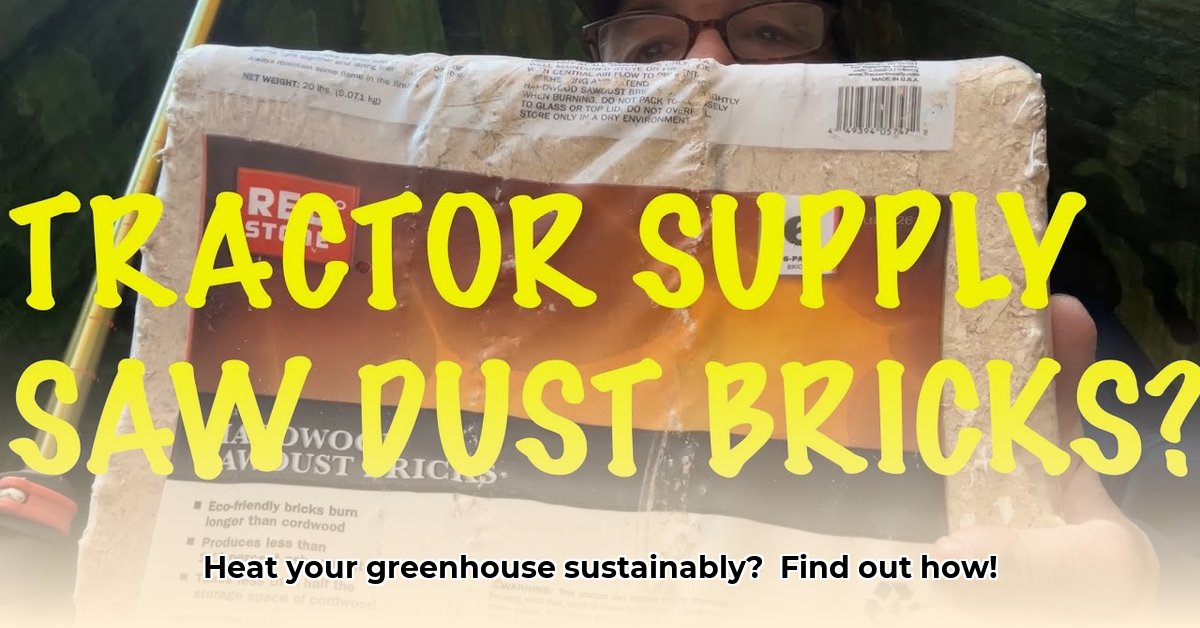
Heating your greenhouse efficiently and sustainably can be challenging. However, a surprisingly simple and affordable solution exists: firebricks. This guide details how to leverage firebricks from Tractor Supply to create a sustainable greenhouse heating system. We'll cover selecting the right bricks, building a safe and effective heater, and ensuring its long-term performance. We'll also explore the environmental benefits and considerations of this approach, particularly for off-grid operations or those prioritizing renewable fuel sources. For additional heating options, check out these heat lamp options.
Choosing the Right Fire Bricks for Your Greenhouse
Selecting the appropriate firebricks is crucial for a successful heating system. Several factors influence this choice:
Greenhouse Size: Larger greenhouses require more bricks for adequate heat distribution. A small greenhouse might need a simple wall of firebricks, while a larger one may demand a more extensive setup.
Budget: Firebricks are relatively inexpensive compared to other heating options, but the total cost will depend on the number needed. Careful planning is key to optimizing both cost and performance.
Heat Retention: Bricks with higher density tend to retain heat better, reducing fuel consumption. This is a vital factor for long-term cost savings and energy efficiency.
Durability: Choose bricks that can withstand repeated heating and cooling cycles. High-quality bricks minimize replacements and ensure a longer lifespan for your heating system.
Tractor Supply offers various firebricks, though not all may be explicitly labeled for greenhouse use. Focus on density and high-temperature resistance when making your selection. Careful pre-purchase research will pay off.
Building Your Firebrick Greenhouse Heating System: A Step-by-Step Guide
Constructing your firebrick heater is relatively straightforward; however, prioritizing safety remains paramount. Always consult local building codes and fire safety regulations before commencing.
Step 1: Planning and Preparation (Safety First!)
Location: Position the heater away from flammable materials like wood or dry plants. Ensure adequate ventilation to prevent smoke buildup. Allow sufficient space around the heater for safety and maintenance.
Foundation: Build a stable, non-combustible base. Concrete is ideal, but a layer of compacted gravel or paving stones can also work, depending on your site conditions. A level base ensures a stable structure.
Step 2: Brick Laying (Design and Construction)
Pattern: Arrange the bricks in a pattern that optimizes heat radiation and airflow. A simple low wall is often sufficient, but more intricate designs are possible. Use high-temperature mortar.
Interlocking: Interlocking patterns enhance strength and improve heat retention. Experiment with different patterns based on your skills and preferences.
Step 3: Chimney Integration (Essential for Safety)
- Ventilation: A properly designed chimney or flue is indispensable for safe smoke venting. It should extend well above the greenhouse roof, preventing smoke from re-entering. Always adhere to local building codes regarding chimney height.
Step 4: Fuel Selection (Sustainable Choices)
- Sustainable Options: Wood is readily available for many, offering a sustainable alternative. However, responsible sourcing is crucial. Consider pellet stoves for improved efficiency (though they represent a higher initial investment).
Step 5: Testing and Refinement (Fine-Tuning for Optimal Results)
- Trial Run: Test your system carefully after construction. Monitor temperatures closely, adjusting airflow as needed for optimal heat distribution and preventing overheating. Refinement is key to maximizing efficacy.
Maintenance and Safety: Long-Term Performance and Risk Mitigation
Regular maintenance is crucial for both safety and longevity.
Inspection: Inspect the firebrick structure regularly for cracks or damage; replace damaged bricks immediately. Even minor damage can compromise safety and efficiency.
Ash Removal: Remove ash buildup to prevent impaired airflow and fire hazards.
Chimney Check: Regularly check the chimney for blockages, reducing airflow and increasing smoke buildup risks. This preventative maintenance is crucial.
Fire Safety: Never leave a fire unattended. Keep a fire extinguisher nearby, and consider adding a smoke detector for extra protection.
Sustainability Considerations: A Holistic Approach to Greenhouse Heating
Using firebricks for greenhouse heating offers a sustainable alternative to traditional methods, particularly in areas with limited electricity access or those seeking fossil fuel reduction. Using biomass fuel minimizes your carbon footprint, but responsible sourcing of the fuel is critical. Sustainable forest management is key to ensure the long-term viability of this approach. Isn't it encouraging that we can create a productive and environmentally conscious greenhouse environment?
Funding Your Sustainable Greenhouse Project: Securing the Resources
While firebricks offer a sustainable, affordable heating solution, securing funding remains vital for many projects. A strong grant proposal highlighting the cost-effectiveness and environmental benefits of your integrated system will greatly enhance your chances of securing funding. Focus on showcasing the long-term economic and ecological advantages of your chosen approach. A well-structured proposal demonstrates your commitment to sustainable agricultural practices.
(Note: For detailed guidance on securing funding, explore resources dedicated to sustainable agricultural funding and grant opportunities.)